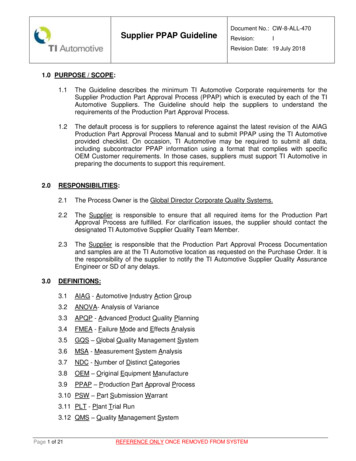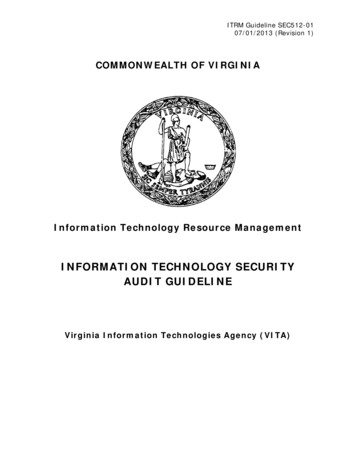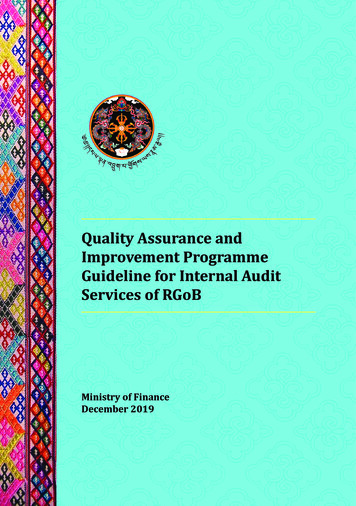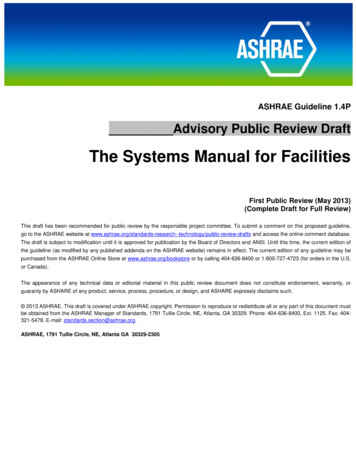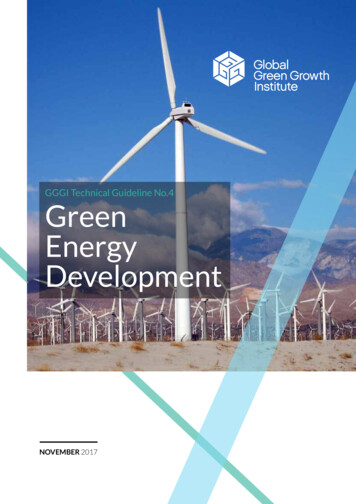
Transcription
1GGGI Technical Guideline No.4GreenEnergyDevelopmentNOVEMBER 2017
2AcknowledgmentThe Green Energy Development Guidelines were developed under the guidance and leadership of Per Olof Bertilsson,Assistant Director-General of the Planning and Implementation Division at the Global Green Growth Institute (GGGI).Dereje Senshaw, Principal Specialist at GGGI, prepared the guidelines. The report benefited considerably from thereview and input of GGGI experts, namely Katerina Syngellakis, Carol Litwin, Dagmar Zwebe, Pheakdey Heng, Jisu Min,Walelign Girma Teka, Gulshan Vashistha, Ahmed Alamra, Karolien Casaer, Chan Ho Park, Srabani Roy, and Inhee Chung.The final draft benefited from valuable editorial and design support by Darren Karjama, Eric Plunkett, Jeong Won Kim,Feelgeun Song, Eliza Villarino, Julie Robles, and Miguel Laranjo.
3ContentsLIST OF BOXES5LIST OF FIGURES6LIST OF TABLES6ABBREVIATIONS AND ACRONYMS7CHAPTER 1: INTRODUCTION81.1 PURPOSE OF THE GUIDELINES91.2 DEFINITIONS OF KEYWORDS AND PHRASES91.3 HOW TO USE THE GUIDELINES121.4 TARGET USERS OF THE GUIDELINES121.5 WHY GREEN ENERGY DEVELOPMENT?12CHAPTER 2: GGGI AND GREEN ENERGYDEVELOPMENT132.1 ENERGY’S DESIRED STRATEGIC OUTCOMES132.2 GGGI’S GUIDING PRINCIPLES ON SERVICE DELIVERY142.3 GGGI’S MAJOR ACTIVITIES IN ENERGY SERVICE DELIVERY TO ACHIEVEENERGY OUTCOMES142.4 INTERVENTION APPROACHES AND MAJOR SERVICE OFFERINGS152.4.1 GGGI intervention approach: Inclusive green energy investment152.4.2 GGGI’s major service offerings in the energy thematic area16CHAPTER 3: HOW TO PLAN AND DEVELOP GREENENERGY PROGRAMS AND PROJECTS3.1 PHASE I: DIAGNOSIS19203.1.1 Macroeconomic review203.1.2 Policy framework assessment and strengthening203.1.3 Institutional assessment21
43.2 PHASE II: GREEN IMPACT ASSESSMENT213.3 PHASE III: ENERGY SECTOR/SUBSECTOR STRATEGY AND PLANNING233.3.1 Step 1. Assessing the energy sector/subsector baseline253.3.1.1 Undertaking integrated baseline assessments and energy demandprojection253.3.1.2 Assessing the financial situation of the energy sector273.3.1.3 Identifying and assessing gaps and needs of the energy sector283.3.2 Step 2. Setting objectives, targets, and measures for green energydevelopment293.3.3 Step 3. Identifying and describing alternative development pathways293.3.4 Step 4. Screening green growth components from the alternative pathways303.3.5 Step 5. Conducting multi-attribute comparison and prioritizing developmentpathways323.3.6 Step 6. Synthesizing and preparing green energy plans3.3.7 Step 7. Conducting sectoral policy and market assessments3.3.8 Step 8. Designing green energy deployment programs3.4 PHASE IV: DESIGNING, FINANCING, AND IMPLEMENTING GREEN ENERGYPROJECTS3.4.1 Step 9. Performing a pre-feasibility study3.4.2 Step 10. Carrying out a feasibility study3.4.2.1 Renewable energy project cycle3.4.2.2 Energy efficiency project cycle3.4.2.3 Preparing a log frame3.4.2.4 GGGI’s policy on sustainability, social, and environmental safeguardsassessments3.4.3 Step 11. Financing3.4.3.1 What makes a project bankable?3.4.3.2 Who contributes to the bankability of green energy projects?3.4.3.3 Indicators of project bankability3.4.3.4 Securing finance3.4.4 Step 12. NCES51ANNEXES54Needs assessment matrix54Typical objectives of green energy planning54Major types of assessments when undertaking feasibility studies55GGGI and partners’ roles and responsibilities in green energy development56
5List of boxesBox 1 Steps in green energy development through the 4 phases of the GGGI value chain11Box 2 Process to plan and develop green energy projects through the 4 phases of the GGGIvalue chain19Box 3 Green growth impact assessment for the government of Central Kalimantan,Indonesia22Box 4 Summary of major GGGI service offerings in Phase I (diagnosis) and Phase II (greenimpact assessment)23Box 5 Projecting energy demand in a partner country25Box 6 The Long-range Energy Alternatives Planning (LEAP) system27Box 7 Evaluation methods for demand-side energy efficiency measures31Box 8 Cost levelization32Box 9 Development of strategies for green energy systems through technical assistance onenergy planning tool: GGGI’s experience in Mongolia33Box 10 Summary of GGGI’s major service offerings in green energy planning, sectoralpolicy and market assessments, and development of green energy deployment programs35Box 11 Approaches to pre-feasibility and feasibility studies for renewable energy andenergy efficiency projects38Box 12 Summary of GGGI service offerings in project design and bankable projectpreparation44Box 13 Summary of GGGI service offerings in the area of financing48Box 14 GGGI’s experience providing energy intervention in Vanuatu49
6List of figuresFigure 1 GGGI’s approach and priority focus areas to address energy sector challengesand meet desired outcomes15Figure 2 Diagnosis of the energy sector20Figure 3 Green impact assessment21Figure 4 Practical implementation of eCBA in 7 stages22Figure 5 Energy sector/subsector strategy and planning23Figure 6 GGGI’s green energy planning process24Figure 7 Design, financing, and implementation of green energy projects36Figure 8 Phase IV of the GGGI value chain37Figure 9 Approaches to pre-feasibility and feasibility studies for developing bankablerenewable energy and energy efficiency projects38Figure 10 Stages in developing bankable energy projects at GGGI40Figure 11 Renewable energy project development cycle (on- and off/mini-grids)41Figure 12 Energy efficiency project development cycle42Figure 13 Results chain for green project design43Figure 14 Matrix for the design and monitoring logical framework44Figure 15 Characteristics of a bankable project45Figure 16 Factors contributing to the bankability of green energy projects46List of tablesTable 1 Sustainable energy and GGGI’s strategic outcomes8Table 2 Definitions of keywords and phrases used in the Green Energy Development Guidelines9Table 3 GGGI’s strategic outcomes and energy sector contribution13Table 4 GGGI’s major service offerings and examples of building track record and a pipeline ofbankable energy projects16Table 5 Guidance on assessing financial conditions related to green growth28Table 6 Requirements for green energy project bankability47
7Abbreviations APNDCNERMNFVNPVOEDPSRFPSDGSOTLTNABusiness as usualExtended cost-benefit analysisEnergy service companyGreen Climate FundGlobal Green Growth InstituteGreen Growth Planning and ImplementationGreenhouse gasGreen Investment Services UnitIntended Nationally Determined ContributionInvestment and Policy Solutions DivisionLong-range Energy Alternatives PlanningNationally Determined ContributionNational Energy Road Map (Vanuatu)National financing vehicleNet present valueOperations Enabling DivisionPolicy Solutions UnitRequest for proposalSustainable Development GoalStrategic outcomesThought Leadership OfficeTechnology needs assessment
8Chapter 1IntroductionThe Global Green Growth Institute (GGGI) works with and supports member countries across four thematic areas: green cities,water and sanitation, sustainable landscapes, and sustainable energy. These guidelines speak to issues in sustainable energy.The energy sector has a dominant role in the transformation toward green growth, which is reflected in the Nationally DeterminedContributions (NDCs) that involve more than 180 countries under the Paris Agreement. All the NDCs include actions related toenergy and specific energy-focused targets. The Sustainable Development Goals (SDGs) recognize the role of the energy sectorin poverty alleviation, improvement of health and wellbeing, employment creation, and economic growth. SDG71 explicitly targetssustainable and affordable access to reliable and modern energy for all.2GGGI’s work in the energy sector directly contributes to four of GGGI’s strategic outcomes (SO) (Table 1).Table 1 Sustainable energy and GGGI’s strategic outcomesINDICATIVE CONTRIBUTION STRATEGIC OUTCOMES (SO)THEMATICAREASUSTAINABLEENERGYSO1: GHGreductionSO2: GreenjobsSO3:Access toservicesSO4: Airquality1 Expanded access to affordableand sustainable energy services 2 Improved sustainable energygeneration mix 3 Enhancement and integrationof energy efficiency THEMATIC FOCUS AREASSO5:EcosystemservicesSO6:Adaptation Source: GGGI’s Refreshed Strategic Plan (2016-2020), 36Energy production and energy use account for around two-thirds of global greenhouse gas (GHG) emissions and are the largestsingle source of emissions. The energy sector is also a significant contributor to local air pollution, and member countries’transformation to green models in energy production, storage, and delivery enables capture of green jobs.GGGI’s energy strategy support explicitly recognizes that the NDCs and SDGs are at the core of combating climate change, reducingair pollution, and providing sustainable access to energy services through the following three priority areas:1 Expanded access to affordable and sustainable energy services.2 Improved sustainable renewable generation mix.3 Enhancement and integration of energy efficiency.GGGI’s partner countries can transform their energy sectors toward a more sustainable path, while meeting growing demands anda call for universal access to energy services. GGGI supports member countries in transforming the energy sector toward having amore sustainable and clean energy mix that provides affordable and reliable energy services for all and meets county targets andactions under the NDCs and SDG7. For this, GGGI works and supports to influence energy sector policy, strategic planning andorigination, and implementation of investment vehicles and projects in line with the above-mentioned three priority areas of support.1Sustainable Development Goal 7 – Access to sustainable and affordable energy service.GGGI, Refreshed Strategic Plan (2016-2020): Accelerating the Transition to a New Model of Growth, freshed-StrategicPlan-2015-2020.pdf.2
91.1 Purpose of the guidelinesGGGI developed these Green Energy Development Guidelinesto assist member countries in developing strategic green energydevelopment plans and implementation road maps at everystage of the GGGI value chain. They serve as a reference forgovernment officials, GGGI staff and consultants, developmentpartners, and relevant stakeholders who are working on areasrelated to or looking to develop a project on green energy. Theyprovide strategies to take toward green energy development, aswell as processes to put these strategies into practice.In summary, GGGI developed the Green Energy DevelopmentGuidelines to: Provide guidance on how GGGI member countries canconduct energy sectoral assessment, and carry out demand/supply mix forecasting; identify, prioritize, and strengthenmainstreaming of green, inclusive renewable energy andenergy efficiency pathways into the national energy sector/subsector strategies and plans to achieve sustainableeconomic, social, and environmental development.Provide guidance to decision-makers on green energy planningand implementation tools, including objectives, targets,measurements, and monitoring and evaluation systems. Provide guidance on how to work with developmentpartners and stakeholders along the GGGI’s value chain inenergy sector’s support intervention. Highlight key GGGI service offerings to partner countries intheir efforts to pursue green growth energy development.The guidelines are organized as follows:Chapter 2 presents GGGI’s desired outcomes from supportinterventions under the energy thematic area, approachesto these support interventions, and projects’ priority areas.Chapter 3 outlines a process for energy sectoral planning andgreen energy project development. The process outlines 12major steps across the GGGI value chain, each with detailedexplanation and schematics.1.2 Definitions of keywordsand phrasesTable 2 provides definitions of important words and phrasesused in this document.Table 2 Definitions of keywords and phrases used in the Green Energy Development GuidelinesIMPORTANT WORDSAND PHRASESDEFINITIONSGreen growth A development approach that seeks to deliver economic growth that is both environmentallysustainable and socially inclusive. It seeks opportunities for economic growth that arelow‑carbon and climate-resilient, prevent or remediate pollution, maintain healthy andproductive ecosystems, create green jobs, reduce poverty, and enhance social inclusion.Green energy development Energy sector/subsector development pathways that implement renewable energy (on- and off-/mini-grids) and energy efficiency projects rather than conventional fossil fuel energy projects.GGGI’s approaches forgreen energy developmentinterventions GGGI uses a comprehensive inclusive green energy investment approach for its green energydevelopment support to member countries. On-grid, off/mini-grids, and/or off-grid (standalone) renewable energy projects: These referto projects or investments that contribute to enhancing renewable energy productionmix and focuses on either or both off/mini-grids and/or standalone renewable energyproduction in order to increase access to sustainable energy in poor rural areas ofmember countries, or encompasses main grid-based projects that enhance sustainableenergy production in member countries.Energy efficiency projects: These refer to projects or investments that focus on efficientuses of energy through promotion of energy efficiency in the public sector, such asdeveloping regulations and building codes in the public sector which contribute to GHGreduction, resource requirement, and climate change mitigation.Pursuing and choosing either/or both types of projects or interventions entirely dependson the member countries’ specific needs. GGGI tailors its assistance to priorities ofpartner governments.The approach systematically addresses four major issues for energy sectors in memberand partner countries: lack of access to reliable and affordable energy, insecure energysupply, energy inefficiency, and air pollution.
10IMPORTANT WORDSAND PHRASESDEFINITIONSGGGI‘s value chain(see box 1 below) Service offeringsBankable green energyprojectsIt is the backbone of GGGI service offerings to member countries. Each component of thevalue chain is followed by a systematic appraisal process that captures learning, sharing, andapplication of experience and knowledge from programs, and ensures the robustness of GGGIadvice and assistance. The four major phases are: Phase I – Diagnosis Phase II – Green impact assessment Phase III – Sector/subsector strategy and planning Phase IV – Design, financing and implementation GGGI’s value chain sets out a green growth energy sectoral planning and implementationapproach for all four phases. GGGI service offerings are products or services derived from the GGGI value chain andoffered to member country governments. The service offerings are designed to establish aprerequisite to the next step of the value chain. The extent to which they drive the processforward is the main determinant of their value. All service offerings are sufficiently standardized and delivered through either the inclusivegreen energy approach or the green energy investment approach, depending on the needsand priorities of member country governments. Renewable energy and energy efficiency projects are identified as technically and financiallyviable, as well as environmentally sustainable and socially inclusive. The green energy planning and development process has 12 major steps, which are continuouslybuilt and interconnected through four interlinked phases along the GGGI value chain.Steps in the planning anddevelopment process ofgreen energy programs andtheir projects Phase I (steps 1 to 6) – This is important for guidance on how to undertake planninggreen energy development programs. The steps include energy sector/subsectorbaseline assessments, energy demand projection, supply mix forecasting, identificationof green energy pathways, prioritization, synthesis of findings, and preparation ofmember countries’ green energy plans. Phase II (steps 7 and 8) – This includes energy sectoral policy and market assessment,as well as design and development of national green energy deployment programs.The steps involved are important in bridging green energy plan creation (Phase III) anddesigning, financing, and implementing green energy projects (Phase IV). Phase III (steps 9 to 11) – This covers pre-feasibility and feasibility studies, and access tofinancing for projects. Implementation partners Phase IV (step 12) – This is essential for designing, financing, and implementing greenenergy projects.Box 1 provides an illustration of the 12 steps and their corresponding phases on the GGGIvalue chain.GGGI’s development partners primarily focus on implementing on-grid and off-/mini-gridrenewable energy projects and energy efficiency projects.
11Box 1 Steps in green energy development through the 4 phases of the GGGI value chainThe GGGI value chain provides the basis for service offerings that the institute delivers to partner countries. It consists offour major phases: diagnosis; green impact assessment; sector/subsector strategy and planning; and design, financing andimplementation. The figure below illustrates key steps under these processes to develop green energy programs and projects forGGGI’s energy thematic area.PHASE I: DIAGNOSISReviews and assesses macroeconomic, policy, and institutional setup in partner countries’ energy sector/subsectors.PHASE II: GREEN IMPACT ASSESSMENTAssesses the implications of green energy pathways on economic, social, and environmental sustainability which includes also anassessment of renewable energy resources and energy efficiency measures.PHASE III: ENERGY SECTOR/SUBSECTOR STRATEGY AND PLANNINGInvolves assessing energy sector baselines, gaps, and needs, as well as forecasting the energy demand and renewable generationmix supply, followed by identifying and prioritizing green energy pathways for partner countries. Interventions focus on facilitatingand creating enabling environments to accelerate and catalyze investment for renewable energy and energy efficiency projects.PHASE IV: DESIGN, FINANCING AND IMPLEMENTATIONFocuses on supporting member governments in developing pipelines of bankable green energy projects that lead to financingand project implementation. GGGI provides support in designing, structuring, and arranging financing capital. Support includesdesigning national financing vehicles and financial instruments to accept and effectively use climate finance toward green energyprojects.Phase IPhase IIPhase IIIPhase IVDIAGNOSISGREEN IMPACTASSESSMENTSECTOR/SUBSECTORSTRATEGY AND PLANNINGDESIGN, FINANCING,AND IMPLEMENTATIONPreparinggreen energyplanSTEPS 1 TO 6Conductingsectoral policyand marketassessmentsSTEP 7Designingrenewableenergyand energyefficiencydeploymentprogramSTEP 8Developingbankable projectsto financialclosureImplementingSTEPS 9 TO 11STEP 12Direct involvement in renewableenergy and energy efficiencydevelopmentAcceleration of investment in green energy projects(renewable energy/energy efficiency) throughpolicies and programsDiagnosisDevelopment,economicgrowth andsustainabilitydiagnosisGreen impact assessmentSectoralgreen ctassessmentSector/Subsector strategy & planningPolicy andinstitutionsanalysisAnalysis ofcosts andinvestmentrequirementsDevelopmentof sectoral/subsectoralinvestmentplans andselectionDesign, financing & implementationDesign:Projectand policypreparationFinancing:Identificationof possiblefinancialstructuresImplementation
12GGGI developed the Green Energy Development Guidelines basedon its experience in providing support to green energy developmentefforts in member countries. The guidelines are neither a manualnor a step-by-step toolkit. Rather, they offer general guidance for theprocess of identifying, prioritizing, planning, and implementing greenenergy development pathways along the GGGI value chain. GGGIadvises users to use additional guidance, handbooks, and tools duringthe planning and implementation of renewable energy and energyefficiency projects to grasp in-depth knowledge and skills.GGGI recommends reading the Green Energy DevelopmentGuidelines completely to understand them thoroughly, as theyprovide major concepts and an overview on how to conduct greenenergy sectoral planning and development — which focuses onrenewable and energy efficiency projects — and mainstreamthis into member countries’ national energy development plans.However, given the wide range of coverage within 12 steps,depending on the knowledge and skill level of the users, theguidelines can be used to meet specific needs of users. For instance,users in member countries where green energy development plansalready exist may not need guidance for steps 1 to 6. These usersmay start with steps 7 and 8. Similarly, users in member countriesthat have recently conducted major pre-feasibility and feasibilitystudies of green energy projects may not need guidance for steps 9and 10. These users may start with step 11.1.4 Target users of the guidelinesThe Green Energy Development Guidelines aim to supportGGGI’s staff who are working on green energy projects inmember countries and help member countries mainstreamgreen energy development into their national energy sector’sdevelopment plans. In addition, the guidelines can also be usefulfor international and national development partners, agencies,private sector partners, and individual experts who work closelywith GGGI’s energy thematic team.In addition, the guidelines give a set of recommended actionsto policymakers, project managers, green energy practitioners,and development partners, while allowing flexibility andcustomization in the country of practice.1.5 Why green energydevelopment?Lack of access to energy affects all aspects of development(e.g. economic, social, and environmental) and quality of life.Improvements in the standard of living include increasedagricultural output, enhanced industrial output, and the provisionof efficient transportation, adequate shelter, health care, andother human services, all of which require access to energy.Therefore, provision of sustainable energy is an importantrequirement to sustainable economic and social development.In addition, fossil fuel energy systems are major contributorsto climate change, accounting for two-thirds of global GHGemissions. Price volatility and logistical concerns, among others,mean that fossil fuels have a negative impact on energy security.Together, these challenges indicate a need to transition to alow-carbon energy sector, which lies at the heart of the greeneconomy and green growth agenda for both emerging andindustrialized economies. Bernardo Salce/ GGGI Cambodia1.3 How to use the guidelines
13Chapter 2GGGI and green energy developmentEnergy is one of the major strategic thematic areas of GGGI. The energy sector plays a dominant role in the promotion andimplementation of green growth. As mentioned above in the introduction section, the dominant role of the energy sector in thetransformation toward green growth is reflected in the submission of NDC covering more than 180 countries preceding the ParisAgreement. In addition, all of the INDC submissions include action related to energy, and around 50 percent of NDCs include specificenergy-related targets to combat climate change.32.1 Energy’s desired strategic outcomesGGGI supports member countries in transforming the sector toward a more sustainable and clean energy mix that providesaffordable and reliable energy services for all and meets country targets and actions under the NDCs and SDG7.GGGI supports member countries in transitioning toward sustainable and renewable energy sources, and enhances energy efficiencyto reduce GHG emissions (strategic outcome 1), improves air quality (strategic outcome 4), and contributes to increased energyaccess to sustainable services (strategic outcome 3). The transition in the energy sector gives rise to opportunities for the creationof green jobs (strategic outcome 2) in member countries. GGGI works across the private and public sectors to foster transformationtoward a more sustainable and green energy sector that facilitates local opportunities for the creation of green energy jobs to ensurethat GGGI’s partner countries capture benefits from global technology development beyond the specific energy sector outcomes.Green energy jobs also contribute to the reduction of energy production and delivery costs and to the development of a sustainableenergy sector. GGGI is in the process of developing and applying innovative approaches that support countries in the development ofgreen jobs in the transformation of the energy sector, and will update the guidelines accordingly.As presented in Table 3, through the energy sector, GGGI aims to support member countries in achieving four strategic outcomes.4Table 3 GGGI’s strategic outcomes and energy sector contribution3STRATEGIC OUTCOMES OF GGGIENERGY SECTOR CONTRIBUTIONStrategic outcome 1,GHG emission reductionReduction in GHG emissions by shifting to renewable energy production andenergy efficiencyStrategic outcome 2,Creation of green jobsGreen jobs from the production of renewable technologies’ components inpartner countriesStrategic outcome 3,Increased access to green, affordable energyExpansion of access to energy by all through additional renewable energyproductionStrategic outcome 4,Improved air qualityReduction in particles per million through transfer from coal and fossil fuel torenewable clean energy production and energy efficiencyGGGI (2017), Thematic Strategies: Focusing GGGI Work for Greater Impact.GGGI (2017), GGGI’s Refreshed Strategic Plan (2016-2020): Accelerating the Transition to a New Model of Growth, reshed-Strategic-Plan-2015-2020.pdf.4
142.2 GGGI’s guiding principles onservice deliveryMore specifically, GGGI aims to:a.GGGI provides in-country service aligned with its guidingprinciples of being objective, independent, and demand-driven.GGGI energy project activities emphasize inclusiveness,considering the impact of proposed programs and projectson the poor and the vulnerable through a formal process andmechanism to provide for the inclusion of such groups andensure they benefit from investments. Other GGGI principles inenergy programs and project interventions include the following: GGGI’s engagement is demand-driven and focuses onsolving the government’s priority problems in the energysector/subsectors without being partial to particular energytechnologies, suppliers, and/or financiers.b.GGGI focuses on building on existing systems/structuresand markets in member countries to catalyze renewableenergy and energy efficiency programs incorporating bestpractices into channel investments. GGGI aims to developand build on what is already in place in member countries,and works to influence current planning processes to pavethe way for renewable energy and energy efficiency.GGGI’s approach is flexible, enabling it to link to andcollaborate with appropriate knowledge partners and withappropriate capacity development, project development,and financing institutions in the energy thematic area.2.3 GGGI’s major activitiesin energy service delivery toachieve energy outcomesIdentify the need for effective national and subnational energysector/subsector planning, accompanied by effective financialand institutional frameworks to enable actions on the ground.Green energy development reflects this outcome by: Assessing the partner country’s energy sector/subsector, socio-economic, political, and environmentalconditions to outline the technical background andstatus quo in relation to the energy sector’s policies,strategies, and plans. Ensuring that the energy policy framework is readyto provide a legitimate and enabling environment forgreen energy interventions.Increase green investment flows that are translated intoconcrete actionable green energy bankable projectsfocusing on both climate mitigation and adaptation. In thisregard, the green energy development process focuses onthe following: The design and application of the investmentprioritization framework and criteria, which identify aprioritized list of green energy investment options. Comprehensive pre-feasibility and feasibility studies,which are conducted to access financing, as well asstrong monitoring and evaluation systems, which mustbe built into the project and maintained throughoutthe process, from concept to implementation. Social and environmental safeguards, which need tobe assessed to ensure that GGGI-supported energyprojects adhere to the necessary standards and allowfor continuous learning and development for bothGGGI and partner governments.In the early stages of planning and project development, GGGIsupports to influence and provide global best practices onsafeguards and how to incorporate this into project design.GGGI will work to achieve its energy strategic outcomesthrough the following major activities: Strengthen green energy concepts in the energy sector/subsector plan and policies at national and subnational levels. Support the realization of green energy plans and policiesthrough the development and financial structuring of bankableprojects, financial instruments, and financing vehicles. Improve multi-directional knowledge sharing and learningin green energy development.Depending on the local government’s needs in partner membercountries, GGGI’s country programs will focus on identifyingpolicy, planning, and regulatory barriers to scaling up renewableenergy, or removing financial barriers through specializedinvestment services for scaling renewable energy generation,access to sustai
3 contents list of boxes 5 list of figures 6 list of tables 6 abbreviations and acronyms 7 chapter 1: introduction 8 1.1 purpose of the guidelines 9 1.2 definitions of keywords and phrases 9 1.3 how to use the guidelines 12 1.4 target users of the guidelines 12 1.5 why green energy development? 12 chapter 2: gggi and green energy development 13 2.1 energy's desired strategic outcomes 13




